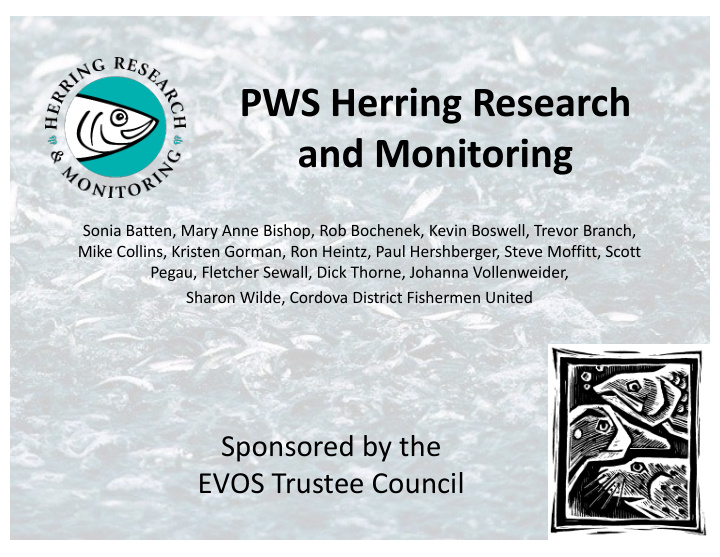



PWS Herring Research and Monitoring Sonia Batten, Mary Anne Bishop, Rob Bochenek, Kevin Boswell, Trevor Branch, Mike Collins, Kristen Gorman, Ron Heintz, Paul Hershberger, Steve Moffitt, Scott Pegau, Fletcher Sewall, Dick Thorne, Johanna Vollenweider, Sharon Wilde, Cordova District Fishermen United Sponsored by the EVOS Trustee Council
Why a herring program?
Design • Began in 2012 – 20 yr study • Starting 2 nd five years • Focused in Prince William Sound • Mix of monitoring and process studies
Goal and Objectives • Improve predictive models of herring stocks through observations and research • Expand and test the herring stock assessment model used in Prince William Sound • Provide inputs to the stock assessment model • Examine the connection between herring condition or recruitment to physical and biological oceanographic factors • Develop new approaches to monitoring
First Five Year Projects • Disease survey • Herring intensive • Adult biomass surveys • Fatty acid analysis • Juvenile index • Acoustic intensive • Age 0 condition • Acoustic validation • Age-1 aerial survey • Disease studies • Determine age of first • Herring tagging spawn • Disease forecasting • Genetic stock structure • Non lethal sampling • Population modeling • Coordination • Herring Scale analysis • Outreach • Data visualization
Current Projects • Modeling – Trevor Branch - UW • Aerial and age surveys – Stormy Haught – ADFG • Acoustic surveys – Pete Rand - PWSSC • Disease research – Paul Hershberger – USGS • Reproductive maturity – Kristen Gorman – PWSSC • Herring Migration – Mary Anne Bishop – PWSSC • Coordination – Scott Pegau – PWSSC • Research fellowship – Maya Groner – Disease • Research fellowship - David McGowan – Recruitment and environment
Acoustic surveys of Juveniles • Large variations in estimated biomass
First Year Growth • Diatom abundance • Summer water temperature • Zooplankton
• Critical size for survival • Size relates to change in • Lipid storage • Growth • Overwintering feeding • Size dependent mortality
Tagging • Demonstrated feasibility • Led to expansion of efforts in current program
Genetics • Genetic similar to east, different to west • Kamishak a mix of two populations
Recruitment • Anticipated a large recruit class in 2015
Disease • Able to detect VHSV antibodies • New perspective on disease in PWS
Current Projects • Modeling – Trevor Branch – UW • PWS crash unusual in magnitude and duration • Aerial and age surveys – Stormy Haught – ADFG • A lot of effort, little spawn, fish ages3-5, older fish missing • Acoustic surveys – Pete Rand – PWSSC • Initial estimates are slightly more fish than last year • Disease research – Paul Hershberger – USGS • Working on determining age structure of fish with antibodies • Reproductive maturity – Kristen Gorman – PWSSC • Difficulty of sampling in June/July • Herring Migration – Mary Anne Bishop – PWSSC • 58 of 125 fish tagged observed at entrances • Coordination – Scott Pegau – PWSSC • Hiring one Postdoc and working on funding for a second
Questions
Recommend
More recommend